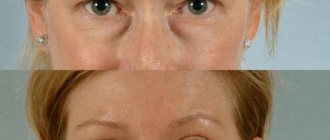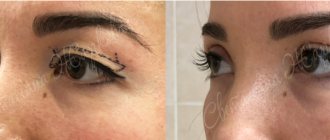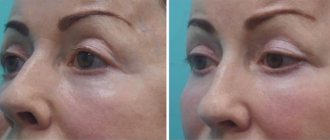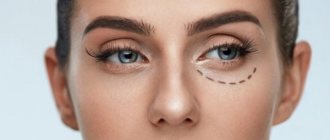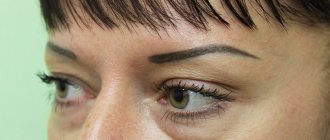As I already said, operations on the face cause the most worries and questions. Recently I set aside a whole day for consultations. And it so happened that it was held under the motto: “I want to know everything about blepharoplasty.”
I've already talked a lot about her. But I will be happy to repeat all the key points. Still, I am a fan of my work. And I can talk about him for hours.
I have prepared for you a series of materials about blepharoplasty, devoting a separate article to each stage. I hope this information answers all your questions and relieves you from worry.
Well, if not, I can always explain everything again during the consultation.
So, let's start with preparing for blepharoplasty.
Characteristics of blepharoplasty
The eyes are the most visible part of the face, so they are difficult to constantly hide under a layer of makeup or glasses. In the presence of obvious eyelid defects, the face takes on a tired, eternally dissatisfied appearance. Eyelid surgery comes to the rescue. The operation is aimed at correcting the upper and lower eyelids, in order to get rid of bags under the eyes, excess skin, and excess fatty tissue of the eyelids. Blepharoplasty allows you to achieve the most long-lasting, pronounced cosmetic effect. Plastic surgery makes it possible to get rid of protruding retrobulbar tissue and sagging skin. It is these defects that give the face a haggard, tired look. In this case, lower blepharoplasty is used. And when performing upper plastic surgery, excess skin folds are eliminated, which open up the patient’s view.
Possible complications and side effects
Surgery is a serious stress for the body. It is impossible to predict the body's reaction, so you should be more attentive to any pathological manifestations. The most common complication is swelling. If it persists for 7 or more days, be sure to inform the surgeon about this and make an appointment for an examination. Also, after blepharoplasty, hematomas, suture dehiscence, and restrictions in the activity of the visual organs may develop. If the patient cannot fully open/close his eyes or feels a sharp deterioration in visual perception, this is not a complication, but a mistake by the surgeon. To avoid serious side effects, carefully select a clinic, a doctor, and take postoperative care responsibly.
Blepharoplasty is one of the most popular plastic procedures. It is low-traumatic, and when performed skillfully, it gives an incredible effect. But any surgical intervention is dangerous for the body. Try to solve the problem using conservative methods and agree to surgery only as a last resort. Go through a comprehensive diagnosis, carefully select a clinic, find out the possible risks, consequences, budget and specifics of recovery. It is very important to find “your” doctor who will understand your wishes and be able to implement them. Only in this case the result will be positive.
More fresh and relevant information about health on our Telegram channel. Subscribe: https://t.me/foodandhealthru
We will be grateful if you use the buttons:
What will be the results?
Age negatively affects the condition of the skin of the face, and in the eyelid area, where particularly sensitive and delicate skin is located, it is especially pronounced. The skin of the upper eyelids sags, due to which a person develops not only aesthetic complexes, but also problems with vision. A common cause of swelling of the eyelids are hernias, which create the visual impression of swelling and bags under the eyes. Blepharoplasty will help get rid of skin folds under the lower eyelids and eliminate excess tissue and skin. However, it is worth noting that it is not always possible to get rid of the so-called “crow’s feet”.
PREOPERATIVE CONSULTATION.
Patient complaints.
“Ever since my youth, when I was 20 years old, I have always had the problem of drooping eyelids. Problems with makeup to apply a line of arrows. Accordingly, with age, the fold only increased and became worse and worse. Age-related changes cannot be avoided, the time has come, it’s time.”
Conversation between doctor and patient.
During the consultation, medical indications are determined. The patient has an excess skin fold of the upper eyelid. The first problem is that the crease hangs over and interferes with applying makeup; it can be a little irritating, especially during the period when there is slight swelling, as it gets larger and interferes with taking beautiful photographs. I don’t like his appearance, he’s tired and gloomy. The second problem is the position of the eyebrows. It's different for everyone. In this situation, the position of the eyebrows is quite low and this cannot be ignored, because the patient is indicated for 2 operations: plastic surgery of the upper eyelids and subsequently endoscopic brow lift.
Taking photographs.
Medical photography is a standard procedure related to medical documentation. You cannot perform aesthetic surgeries to change your appearance or correct age-related changes or birth defects without photographs. We need photography to evaluate the results before and after. Photographing is performed in 3 projections: frontal, lateral and semi-lateral, with eyes closed and open. In these positions it will be clearly visible what excess skin of periorbital hernias was before the operation and what result we will get in the end.
Marking.
An important step before surgery. At the preoperative marking stage, it is important to assess the volume of skin that is to be removed. It is known that there are certain limits, these are 9 mm from the eyelash edge and 15 mm from the eyebrow growth line. Within these limits, the skin fold can be removed. You cannot remove any more, otherwise you may get a noticeable scar that will not fit into the fold of the upper eyelid. You may also get the effect of emptiness in the area of the upper eyelid, which makes you look older and gives you age. And our goal is to get a rejuvenation effect. Therefore, it is important to consider how much skin and fatty periorbital hernias to remove. You can't do hypercorrection, because... This will make you look older and look exhausted. It is better not to remove more tissue than to go through it during surgery. But another important point is that when we potentially know that there will be a brow lift surgery, we should not remove too much skin. Otherwise, in the future, when raising the eyebrows, there will be excessive tension, as well as the effect of emptiness of the upper eyelid and tension when closing the eyes. But another important point is the cut. When we first perform upper eyelid surgery and then endoscopic brow lift, we must take into account how we will draw the incision line, since when the eyebrow is raised, the incision may extend onto the eyebrow and become noticeable.
Where is eyelid surgery performed?
Eyelid correction is performed exclusively on an outpatient basis, as it requires the use of anesthesia. Norcosis can cause a negative reaction in the body and affect the respiratory system. A consultation with an anesthesiologist is required, who can identify contraindications to any type of anesthesia and clarify your medical history. To perform blepharoplasty, local anesthesia in combination with sedative injections is sometimes sufficient. The patient will experience discomfort only when the drug is administered, since it is injected quite deeply, and the skin in the eye area is sensitive.
Definition of contraindications
First of all, the doctor carefully interviews the patient. He determines whether he has diseases of the heart, kidneys, liver, blood vessels, blood, respiratory and nervous systems, and whether he has allergies to medications. The hereditary factor plays an important role, so the specialist is interested in diseases that close relatives suffered from.
If the patient agrees that he has diseases of his organs and systems, or the doctor suspects a previously undetected pathology, the patient must be thoroughly examined. If there are no serious deviations that could interfere with blepharoplasty, then you can prepare for the operation itself.
An ophthalmological history is also determined. Eye diseases may be a contraindication to surgery. So, the surgeon rarely allows the patient to undergo surgery if he has dry eye syndrome, this can cause complications and lead to an unsatisfactory result.
But this is not a critical contraindication - if the disease is cured, surgery will be scheduled. In the presence of chronic eye diseases, the prognosis is less favorable - blepharoplasty is contraindicated for life in such patients.
The surgeon needs to know about previous eye surgeries, including vision correction. If repeated blepharoplasty is planned, then complete information about the previous intervention will help the surgeon competently plan the operation and anticipate possible complications. In many situations, examination by an ophthalmologist, psychologist, or surgeon before surgery is considered mandatory.
We recommend: When is blepharoplasty necessary for men?
Is it painful to make a correction?
During the operation, you will not feel pain due to the use of local or general anesthesia. After the procedure, most often, there is no pain either. During the first two days after blepharoplasty, it is recommended to reduce activity and get plenty of rest. Such actions will facilitate rehabilitation and minimize the risk of swelling and complications. In the first time after correction, there may be an increase in sensitivity in the corners of the eyes. To eliminate discomfort, the doctor may prescribe regular paracetamol. Stronger painkillers are not necessary. To reduce swelling, you should sleep only on your back, with the head of the bed raised.
Is surgery performed only on older patients?
Blepharoplasty is not only performed on older patients. Indications for this procedure include not only age-related changes, but also congenital or acquired eyelid defects. And age is an individual matter, everyone has their own aging process. During your appointment, the plastic surgeon will tell you whether plastic surgery is worth it and will recommend the most appropriate technique in your case.
Medical examination
Before blepharoplasty, you must undergo a medical examination.
It will consist of several stages.
It all starts with a consultation with a plastic surgeon. There, a specialist will examine you, identify problem areas and collect a primary medical history.
You can sign up for a consultation with me by following the link.
Next, you will be sent for an examination consisting of:
- Laboratory tests of blood and urine.
- Electrocardiograms.
- Fluorographic examination of the lungs.
- Therapist consultations.
- Consultations with highly specialized doctors.
How does the healing process proceed?
When performing surgery on the upper or lower eyelids, slight bruising will be present in any case. Ideally, they should disappear within a month. Moderate swelling is also observed, most noticeable in the area of the edges of the postoperative wound. During sleep, the eyes may be slightly open, this is caused by a weakening of the muscle tone of the eyes. In this case, the doctor may prescribe a special eye ointment, which is designed to keep the cornea from becoming infected and drying out.
A month after eyelid surgery, the patient may feel dry eyes. This is due to the fact that removing excess skin provokes more dust. It is recommended to blink more often at this time to moisturize the cornea. Over time, the eyes adapt to the new condition.
If during the rehabilitation process you feel increased fatigue and weakness, do not panic. This is a normal state when all the body’s forces are directed towards the healing process. You can wash your hair and shower the day after surgery. For the first week, you should avoid eyelid makeup.
Preparation for eyelid surgery
On the eve of the operation, the doctor will prescribe all the necessary tests for you. A month before blepharoplasty, you need to stop taking medications that can slow down the healing process. Be sure to have a good rest and sleep before undergoing plastic surgery, you will need strength. Arrange with someone from your family to accompany you home after the correction and stay with you for two days. This will not only give you the opportunity to have a good rest, but will also help you avoid any physical labor associated with household chores.
And, remember, a positive attitude and faith in the result play a big role. Blepharoplasty has been performed for many years, and there are many qualified, experienced specialists who will perform the operation as carefully as possible, without the risk of complications.
